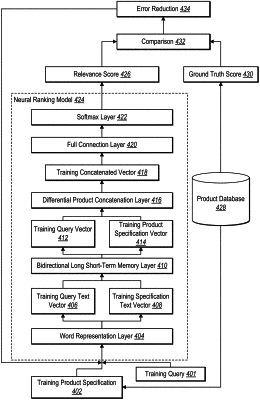| CPC G06Q 30/0631 (2013.01) [G06F 16/583 (2019.01); G06F 16/951 (2019.01); G06N 3/08 (2013.01); G06V 10/764 (2022.01)] | 7 Claims |

|
1. A system comprising:
at least one processor; and
a non-transitory computer readable medium comprising instructions that, when executed by the at least one processor, cause the system to:
identify a training query that corresponds to a first product specification of a training product, wherein the training product corresponds to a plurality of training product specifications;
train a neural ranking model comprising a bidirectional long short-term memory layer and a differential product concatenation layer to generate relevance scores between product specifications and digital queries by, for each training product specification of the plurality of training product specifications:
generating a training concatenated vector utilizing the differential product concatenation layer to concatenate a difference vector representing a difference between a training query vector and a training product specification vector together with a product vector representing a product of the training query vector and the training product specification vector;
generating a relevance score indicating a measure of correspondence between the training product specification and the training query by utilizing the bidirectional long short-term memory layer to process the training concatenated vector; and
comparing the relevance score to a ground truth score for the training product specification, the ground truth score indicating whether the training product specification is the first product specification that corresponds to the training query.
|